377. Presumably we should
count from the headless Rogo up to and including Rogo
with his head intact:
 |
170 |
 |
 |
 |
 |
 |
 |
|
Gb1-3 (232) |
Gb6-21 (403)
|
Gb6-22 |
Gb6-23 |
Gb6-24 |
Gb6-25 |
Gb6-26 |
|
177 = 6 *
29½ |
And this way of inclusive counting
could have been the standard used for measuring out half-years,
where the
counting could not move past the end points.
 |
180 |
 |
|
Ga1-4 |
Ga7-16 |
|
182 = 7 * 26 |
... In north Asia
the common mode of reckoning is in half-year, which are not to
be regarded as such but form each one separately the highest
unit of time: our informants term them 'winter year' and 'summer
year'. Among the Tunguses the former comprises 6½ months, the
latter 5, but the year is said to have 13 months; in Kamchatka
each contains six months, the winter year beginning in November,
the summer year in May; the Gilyaks on the other hand give five
months to summer and seven to winter. The Yeneseisk Ostiaks
reckon and name only the seven winter months, and not the summer
months. This mode of reckoning seems to be a peculiarity of the
far north: the Icelanders reckoned in misseri,
half-years, not in whole years, and the rune-staves divide the
year into a summer and a winter half, beginning on April 14
[4-14] and October 14 respectively. But in Germany too, when it
was desired to denote the whole year, the combined phrase
'winter and summer' was employed, or else equivalent concrete
expressions such as 'in bareness and in leaf', 'in straw and in
grass' ...
The 'fish-eyes' below the
waist of Pachamama were probably also never meant to be
more than 177:
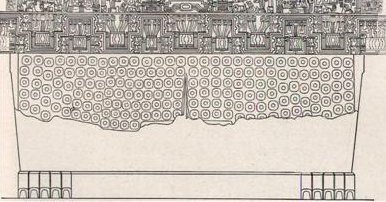
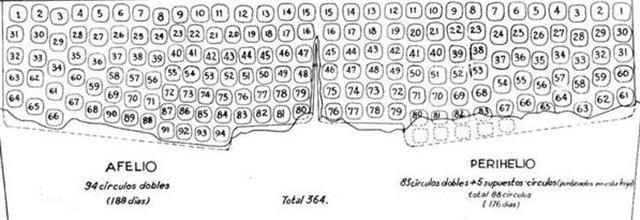
...
The principal word
for 'fish' in most Dravidian languages is min, which has
an ancient homophone meaning 'star', both probably derivatives
of the root min 'to glitter' ... Fish are actually unable
to close their eyes, and the fact that 'when the fish sleeps it
does not close its eyes' was noticed by ancient Indians. The
dot-in-a-circle similar to that occuring among the trefoils of
the Harappan priest-king´s robe is identical with the eye of the
many small hare- and fish-shaped amulets discovered on the lower
levels of Harappa ...

If 88 always had denoted Betelgeuze, then 94 (=
88 + 6) could always have denoted the place preceding Canopus -
which might have persuaded the creator of the stone figure of
Pachamama (World Mother) to have 94 circulos dobles
on her right leg. The canopy star marked where dry land (year of
straw) was beginning.

|
CLOSE TO THE SUN: |
|
4-2 |
4-3 |
4-4 |
4-5 (95) |
4-6
(*16) |
|
APRIL 17
(107 = 91 + 16) |
18 |
19 |
20 (*30) |
21 |
 |
 |
 |
 |
 |
|
Ga1-27 |
Ga1-28
(→ 12 + 16) |
Ga1-29 |
Ga1-30
(→ 14 + 16) |
Ga2-1 |
|
6h
(91.3)
ν
Orionis (91.4), θ Columbae (91.5), π Columbae (91.6) |
ξ
Orionis (92.5) |
Al Han'ah-4 (Brand) /
Maru-sha-pu-u-mash-mashu-7 (Front of the Mouth of
the Twins)
TEJAT
PRIOR = η Gemini
(93.4), γ Monocerotis (93.5), κ Aurigae (93.6), κ
Columbae (93.8)
*52 =
*93.4 - *41.4 |
FURUD
= ζ Canis Majoris
(94.9) |
Well-22 (Tapir) /
Arkū-sha-pu-u-mash-mashu-8
(Back of the Mouth of the Twins)
δ
Columbae (95.2),
TEJAT
POSTERIOR = μ Gemini,
MIRZAM (The Roarer) = β Canis Majoris
(95.4),
CANOPUS = α Carinae
(95.6),
ε Monocerotis (95.7), ψ1 Aurigae (95.9)
*54 =
*95.4 - *41.4 |
|
June 20 |
SOLSTICE |
22 (*93) |
23 (174) |
ST
JOHN'S DAY |
|
°June 16 |
17 (168) |
18 |
19 |
20 (*91) |
|
'May 24
(144) |
25 (290 / 2) |
26 |
27 |
28 (*68) |
|
"May 10
(130) |
11 (314 - 183) |
12 |
13 (*236
- *183) |
14 (*54) |
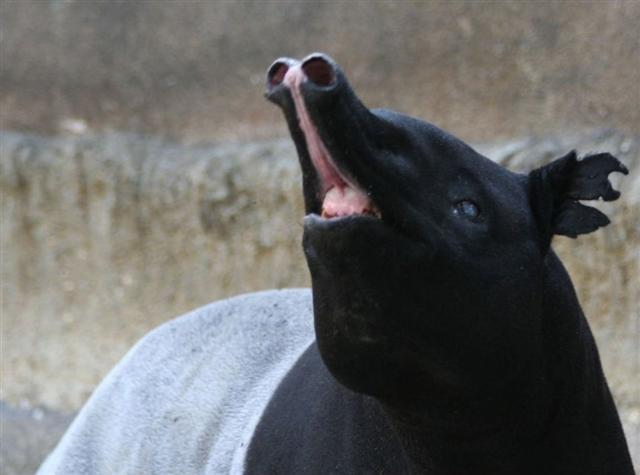 |
|
CLOSE TO THE FULL
MOON: |
|
10-2 |
10-3 |
10-4 |
10-4 |
10-5 |
|
OCT 17
(290) |
18 |
19 |
20 |
21
(*214) |
|
ZHŌNGSHĀN = ο Herculis
(274.0),
π Pavonis (274.6) |
ι
Pavonis (275.1),
POLIS =
μ Sagittarii
(275.9)
MENKAR (α
Ceti)
|
η
Sagittarii (276.9) |
Purva Ashadha-20 (Winnowing Basket) |
|
KAUS MEDIUS = δ Sagittarii,
κ Lyrae (277.5),
TUNG HAE (Heavenly Eastern Sea) = η Serpentis
(277.7),
SHAOU PIH (Minor Minister) = φ Draconis
(277.8),
KWEI SHE = χ Draconis
(277.9) |
φ Oct. (278.1),
KAUS AUSTRALIS = ε Sagittarii
(278.3), ξ Pavonis (278.4),
AL ATHFAR (The Talons of the Falling Eagle) = μ
Lyrae
(278.6)
*237 =
*278.4 - *41.4 |
|
Dec 20 |
SOLSTICE |
22 |
23 (357) |
CHRISTMAS EVE |
|
°Dec 16 |
17 |
18 |
19
(*273) |
20 (354) |
|
'Nov 23
(327) |
24 |
25 |
26
(*250) |
27 |
|
"Nov 9 |
10 (314) |
11 |
12 (*236
= 8 * 29½) |
13 |
... Originally
the highly born family of the Sun, Moon, and stars dwelt in
a cave on the summit of Maunga-nui, Great Mountain,
in the ancient homeland. They were not at all comfortable in
their gloomy home for they could not see distinctly and
their eyes watered constantly
...
... The jaguar
learned from the grasshopper that the toad and the rabbit
had stolen its fire while it was out hunting, and that they
had taken it across the river. While the jaguar was weeping
at this, an anteater came along, and the jaguar suggested
that they should have an excretory competition. The
anteater, however, appropriated the excrement containing raw
meat and made the jaguar believe that its own excretions
consisted entirely of ants. In order to even things out, the
jaguar invited the anteater to a juggling contest, using
their eyes removed from the sockets: the anteater's eyes
fell back into place, but the jaguar's remained hanging at
the top of a tree, and so it became blind. At the request of
the anteater, the macuco bird made the jaguar new eyes out
of water, and these allowed it to see in the dark. Since
that time the jaguar only goes out at night. Having lost
fire, it eats meat raw. It never attacks the macuco
...
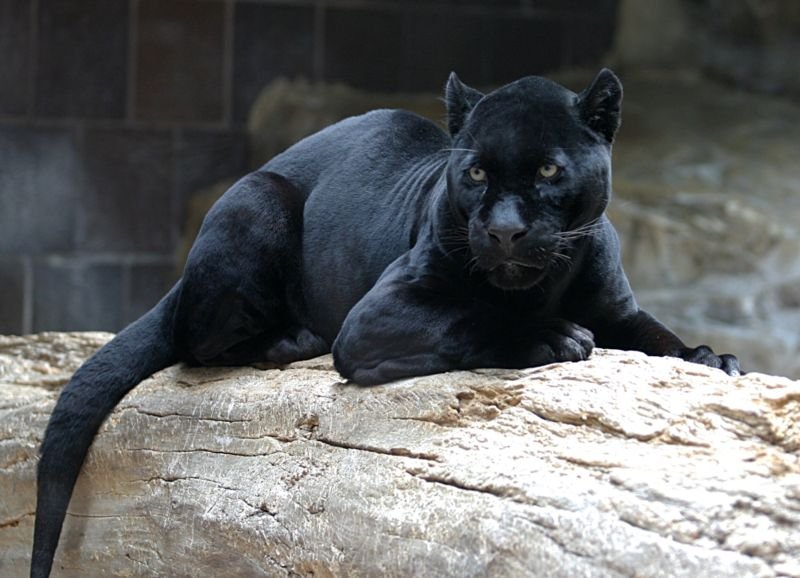
I am suggesting Rogo stretching his
head up in Gb6-26 was at the cardinal point where the Sun
was emerging again after his nightside journey down in the
'water':
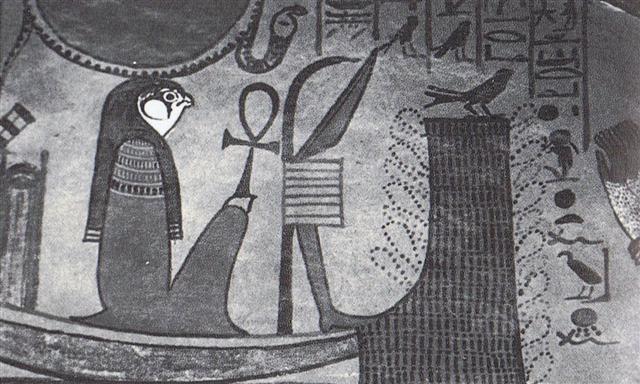
|
CLOSE TO THE SUN: |
|
4-17
(*392) |
4-18 (108) |
4-19
(*29) |
4-20 (→
12 * 35) |
|
MAY 2
(*42) |
3 (123 =
408 - 285) |
4 (4 * 31) |
5 (125 +
365) |
 |
 |
 |
 |
|
Gb6-25 (229 + 178) |
Gb6-26
(408) |
Gb6-27 |
Gb6-28
(45 + 365) |
 |
 |
 |
 |
|
Ga2-12 |
Ga2-13 |
Ga2-14 |
Ga2-15
(45) |
|
7h
(106.5)
no star
listed (106) |
WEZEN
(Weight) = δ Canis Majoris
(107.1), τ Gemini (107.7), δ Monocerotis (107.9) |
no star
listed (108) |
λ Gemini
(109.4),
WASAT
(Middle) = δ Gemini
(109.8)
*68 =
*109.4 - *41.4 |
|
July 5
(186) |
6 (*107) |
7 |
8 |
|
°July
1 (182) |
2 |
3 (*104) |
4 |
|
'June 8
(159) |
9 (*80) |
10 |
11 |
|
"May 25 (144) |
26 |
27 |
28 (*68) |
|
CLOSE TO THE FULL
MOON: |
|
10-16 |
10-17
(*210 = 420 / 2) |
10-18 |
10-19 |
|
OCT 31
(304) |
NOV 1 |
2 |
3 (*227
→ π) |
|
Al
Na'ām-18 (Ostriches)
/
Uttara Ashadha-21 (Elephant tusk, small bed)
NUNKI
= σ Sagittarii
(288.4), ζ Cor. Austr. (288.5),
MANUBRIUM = ο Sagittarii
(288.8),
ζ Aquilae (288.9)
*247 =
*288.4 - *41.4 |
19h
(289.2)
λ
Aquilae (Ant.) (289.1), γ Cor. Austr (289.3), τ
Sagittarii (289.4), ι Lyrae (289.5), δ Cor. Austr.
(289.8)
*248 =
*289.4 - *41.4 |
Al Baldah-19 (City)
AL BALDAH = π Sagittarii, ALPHEKKA (Dish) MERIDIANA
= α Cor. Austr.
(290.1), β Cor. Austr. (290.2) |
ALADFAR
= η Lyrae
(291.1),
NODUS II = δ Draconis
(291.5),
ψ Sagittarii (291.6), τ Draconis (291.7), θ Lyrae
(291.8) |
|
...
This [σ
Sagittarii] has been identified with Nunki of
the Euphratean Tablet of the Thirty Stars,
the Star of the Proclamation of the Sea, this Sea
being the quarter occupied by Aquarius, Capricornus,
Delphinus, Pisces, and Pisces Australis. It is the
same space in the sky that Aratos designated as
Water
...
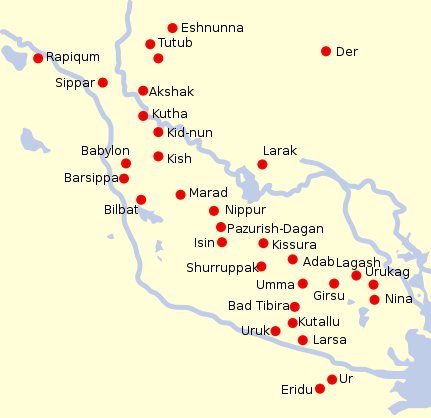
... This [η
Carinae] is one of the most noted objects in the
heavens, perhaps even so in almost prehistoric
times, for Babylonian inscriptions seem to refer to
a star noticeable from occasional faintness in its
light, that Jensen thinks was η. And he claims it as
one of the temple stars associated with Ea, or Ia,
of Eridhu¹, the Lord of Waters, otherwise known as
Oannes², the mysterious human fish and greatest god
of the kingdom.
¹ Eridhu, or
Eri-duga, the Holy City, Nunki, or Nunpe, one of the
oldest cities in the world, even in ancient
Babylonia, was that kingdom's flourishing port on
the Persian Gulf, but, by the encroachment of the
delta, its site is now one hundred miles inland. In
its vicinity the Babylonians located their sacred
Tree of Life.
² Berōssōs
described Oannes as the teacher of early man in all
knowledge; and in mythology he was even the creator
of man and the father of Tammuz and Ishtar,
themselves associated with other stars and sky
figures. Jensen thinks Oannes connected with the
stars of Capricorn; Lockyer finds his counterpart in
the god Chnemu of Southern Egypt; and some have
regarded him as the prototype of Noah ... |
|
Jan 3
(*288) |
4 |
5 (370) |
6 |
|
°Dec
30 (364) |
31
(*285) |
°Jan 1 |
2 |
|
'Dec 7 |
8 |
9 (*263) |
10 (344) |
|
"Nov 23 |
24 |
25 (*249) |
26 (330) |
 |
 |
 |
 |
|
Ga8-21 |
Ga8-22
(408 - 183) |
Ga8-23 |
Ga8-24
(227) |

|

















